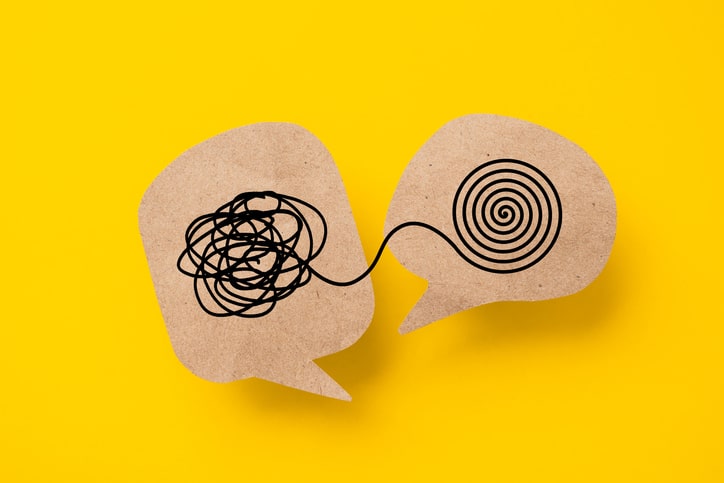Conversations are a delicate dance and a matter of interpretation between the sender and receiver. You never truly know what the outcome will be, regardless of your best intentions or the depth or longevity of the relationship.
What gets said and what is perceived can differ based on an individual’s preconceived notions and underlying drivers. Furthermore, each person’s wants, needs, inherent beliefs, biases, and perspectives are instrumental in processing, interpreting, and responding to the messages they hear.
Cultivating meaningful relationships takes commitment and reciprocity, where both parties trust and feel comfortable being real and speaking up.
Gain insight through the use of the Enneagram.
The Enneagram assessment helps you learn about your core motivations, behaviors, and instinctual patterns. This knowledge will assist you in gauging how best to assert what’s essential to you, while adapting to another person’s preferences, e.g., tone, word choice, body language, and timing.
From a relationship standpoint, the Enneagram Couples Report helps couples appreciate one another from a fresh perspective, with strategies to help them bond more genuinely. The report includes 48 pages of customized content reflecting 18 relationship themes and dynamics of you and your partner, while shining a light on your strengths and exploring the challenges you may face alone and together.
Additionally, the personalized document highlights you and your partner’s type characteristics and the pertinent subtleties that make each of you, YOU, along with key patterns that are crucial to comprehend to sustain a healthy and supportive relationship.
It’s all relational.
When you’re in a partnership, the interaction between the two of you creates a third element—an “Us”—which is multidimensional and complex, where you can unconsciously or consciously activate the best or the worst in each other.
The Enneagram can help you both understand one another from multiple perspectives and expand your potential to be more compassionate and listen with positive intention. You will feel more fulfilled and at peace when you show up from a grounded and authentic place.
Here are six noteworthy factors impacting how you both show up and talk with one another:
#1 Core motivation.
The Enneagram Core Type reflects an idealized self-image and is defined by a deep, often unconscious core motivation that serves as the main driver for how you and your partner show up. Further, this driving force explains why you do what you do and reveals your story about how the world works and what you can expect from it, influencing what you believe, see, and experience.
#2 Focus of attention.
Your Type’s core motivation creates a specific focus of attention, i.e., an aspect or area of life you’re more attuned to. Your attention becomes a filter that determines what you will and will not notice, feel, or think about as you go through your day. When you know your habitual tendencies and what you hyperfocus on, you can expand beyond your typical fixations or movements to recognize their effects on those in your orbit and manage them more successfully. On the other hand, your beliefs often filter your perceptions and can generalize, twist, block out, and delete information that does not align with your type’s ideal image or preferences.
#3 Instinctual patterns.
Each of the nine Enneagram Types merges with one of three instincts, affecting how you interact and relate to yourself, people, and your environment. These instincts are labeled self-preservation, one-to-one (also known as sexual), and social, and are “hardwired” in you for survival. You have a dominant instinct, a second that supports it, and a third that is least developed and a potential area of weakness. Your dominant instinct reveals how you operate when stressed out and in survival mode. While you can’t completely eliminate automatic reflexes, you can learn how to curtail them. For example, taking a breath and pausing when triggered can allow you to determine how best to respond.
#4 Centers of Expression.
When interacting with you, others notice your “Centers of Expression,” which correlate to how you think, act, and feel. You have access to all three centers, and the iEQ9 Enneagram Assessment indicates which of your centers are expressed strongly, in what order, and which may be neglected. The energy and nature of your dominant center can influence whether your partner experiences you as a thinker, doer, or overly emotional, and can impact how you two speak and listen. To create balance individually and collectively means equally nurturing your head, heart, and body, aka thinking, feeling, and action centers, in the way your particular Type needs.
#5 Social Style.
The Enneagram Social Style indicates how you engage with those around you and the tactics you use to get what you want and need. Understanding each other’s default mode can help you navigate how best to communicate with one another and those in your inner circle. The three styles are: (1) Assertive, which has a take charge attitude and feels energized discussing and debating topics, (2) Compliant, which are driven to follow the rules and are galvanized by being clear, courteous, and well-mannered in discussions, and (3) Withdrawn, who are eager to have space and time to reflect and connect deeply with their thinking and feeling before entering dialogue.
#6 Conflict Style.
The Enneagram describes three conflict styles regarding your Type’s typical inclination to protect against conflict, obstacles, and disappointment. The Avoidant style operates as an “escape artist” who seeks a positive outlook or harmonious outcome to get away or make the issue disappear. Next is the Methodical style, which takes a logical and competency-based approach to address the matter. Then there is the Reactive style, which thrives in debates, responding impulsively and strongly with intensity and directness. Even if you and your partner are the same type, unique circumstances, behaviors, and events will likely affect you differently. For example, for some, it can be another person’s tone or a misinterpreted meaning. For others, their emotional projection can cause communication snafus where an immediate repair is needed.
Relating more openly and compassionately.
The Enneagram framework invites you to be more aware of yourself and others. It provides strategies to create balance and eliminate conditioned behaviors that no longer serve you individually and in partnership. Accepting and supporting each other’s preferences, sensitivities, challenges, and growth edges can bring you closer and empower you to tap into your highest expression.
Activate your best with those around you.
Self-leadership is about getting to know yourself better and applying that knowledge to how you interact in your relationships. As a lifelong student, certified professional coach, and consultant, activating the best in others through self-leadership, interpersonal relations, and team dynamics are passions of mine. My approach is personalized and customized, tapping into various assessments, disciplines, modalities, and techniques. Also, check out my “Micro & Mini Service Offerings” and try one session to inspire you. Sign up solo or with another person or group to work on a specific exercise or activity and split the costs! Contact me to get started.

